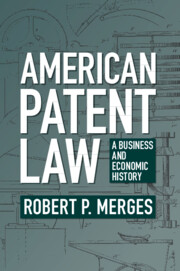Book contents
- American Patent Law
- American Patent Law
- Copyright page
- Dedication
- Contents
- Figures
- Tables
- Preface
- 1 Introduction
- 2 Founding Era Patent Law, 1790–1820
- 3 The Jacksonian Era and Early Industrialization, 1820–1880
- 4 Corporatization, 1880–1920
- 5 1921–1982: Patents In and Out of the Headlines
- 6 The Federal Circuit Era
- 7 In Conclusion
- Index
5 - 1921–1982: Patents In and Out of the Headlines
Published online by Cambridge University Press: 02 February 2023
- American Patent Law
- American Patent Law
- Copyright page
- Dedication
- Contents
- Figures
- Tables
- Preface
- 1 Introduction
- 2 Founding Era Patent Law, 1790–1820
- 3 The Jacksonian Era and Early Industrialization, 1820–1880
- 4 Corporatization, 1880–1920
- 5 1921–1982: Patents In and Out of the Headlines
- 6 The Federal Circuit Era
- 7 In Conclusion
- Index
Summary
The Progressive Era antitrust movement left its imprint on the patent system, as we saw in the last chapter. But as we also saw, the imprint was light. The patent system was not much changed by virtue of the Oldfield Hearings of 1912 and related congressional inquiries. Nevertheless, a precedent was set. While patent specialists followed the professionalizing path, pro-consumer voices in Congress and advocates of the evolving antitrust laws had both established that patent-related activity was likely to cause economic harm. Little came of this in the 1920s, but after the onset of the Depression big business skeptics aimed their fire at patents with a force rarely seen in this corner of economic policy. The Oldfield Hearings turned out to be a mere dress rehearsal for the main event. The Temporary National Economic Committee Hearings of 1935 made the earlier Oldfield initiative look like a patent fan club. For the first time in the United States,1 serious voices were calling for the abolition of the patent system, or, at minimum, a radical overhaul of some of its primary features.
- Type
- Chapter
- Information
- American Patent LawA Business and Economic History, pp. 275 - 375Publisher: Cambridge University PressPrint publication year: 2023



